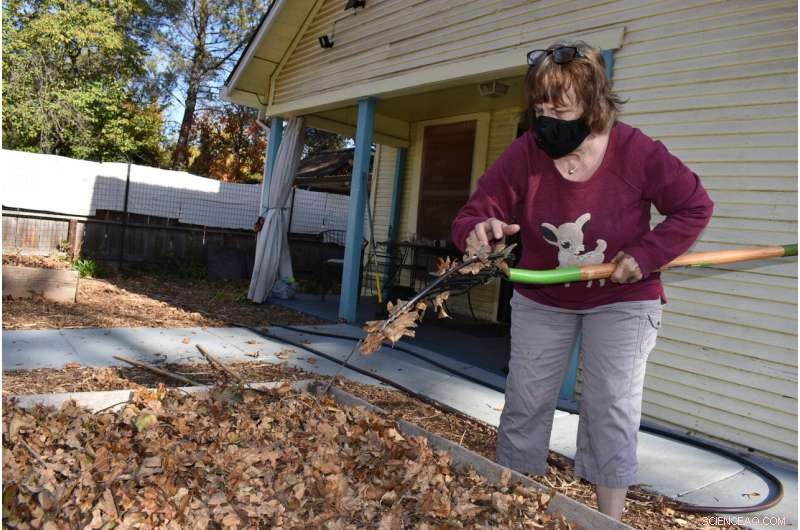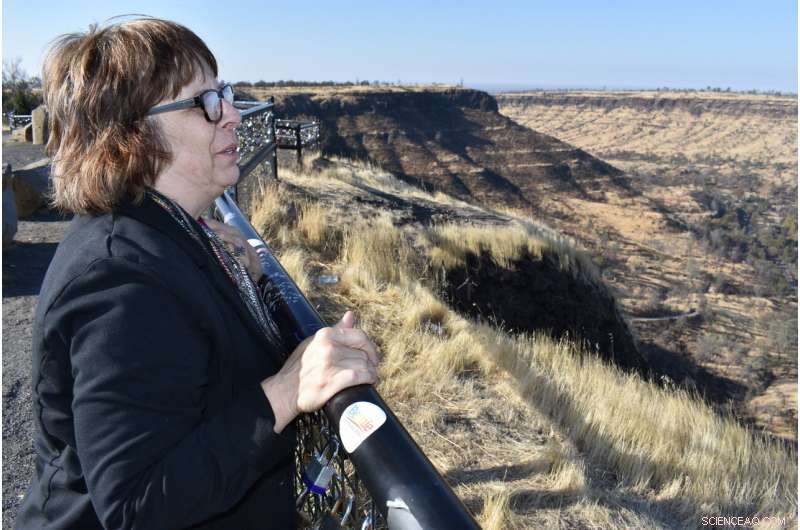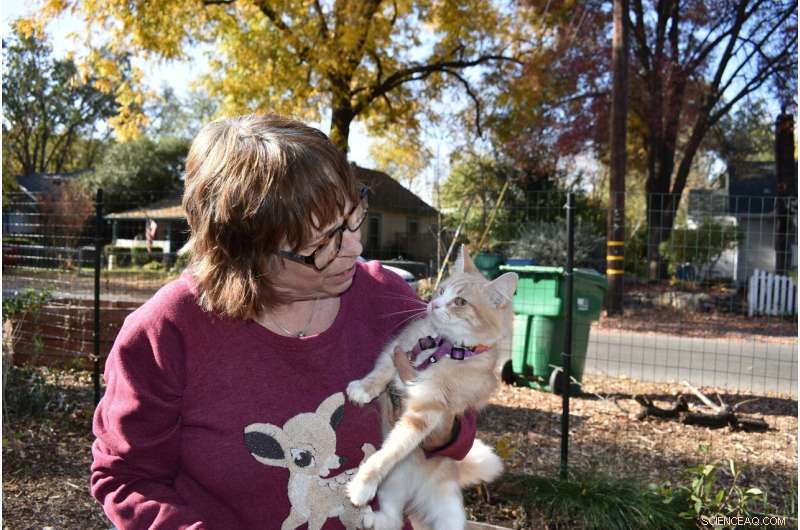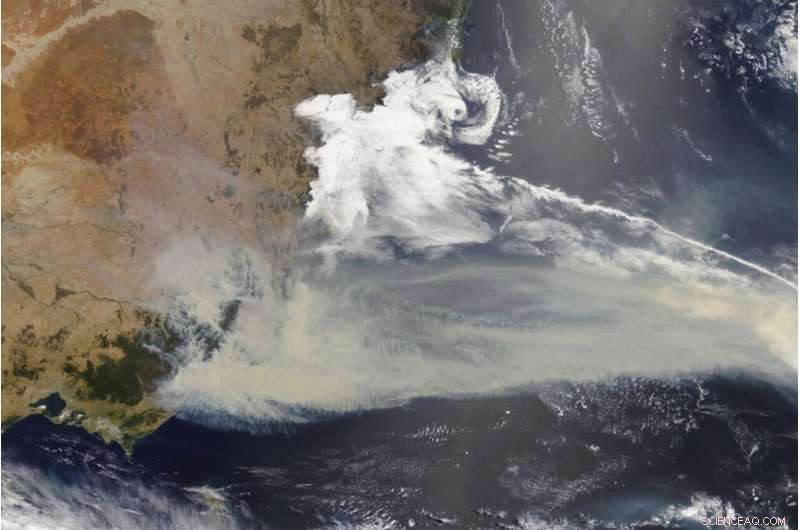
In questa foto non datata fornita dal California National Primate Research Center, scimmie rhesus sono viste nel loro recinto all'aperto presso il California National Primate Research Center di Davis, California Un gruppo di animali esposti al fumo di un incendio da neonati ha sviluppato polmoni che sono circa il 20 percento più piccoli di altre scimmie rhesus. (CNPRC/Università della California Davis tramite AP)
Prima vennero le fiamme, una violenta tempesta di fuoco spinta da raffiche di vento a 50 mph (80 km/h) che ha incenerito la casa di Kelsey Norton e ucciso 85 persone nella sua comunità.
Poi venne il fumo, non solo dalla foresta ma anche da circa 14, 000 case e il loro contenuto che bruciarono, generando uno spesso pennacchio che ha avvolto parti della California settentrionale per settimane e ha lasciato Norton senza fiato.
E poiché il fuoco, ormai da più di un anno, è stata una malattia:ripetute infezioni respiratorie che indeboliscono le forze di Norton, interferire con il suo lavoro e lasciare la trentenne infermiera di cardiologia preoccupata per futuri problemi di salute.
"Non voglio avere il cancro a 50 anni perché ho inalato il fumo a 30 anni, " lei disse.
L'immediato bilancio delle vittime e delle proprietà perse quando un incendio divampò attraverso la città di Paradise, ai piedi delle colline della Sierra Nevada, La California nel novembre 2018 è ben documentata. Ancora sconosciuto è l'impatto a lungo termine dell'intensa esposizione al fumo subita dai sopravvissuti alla tragedia e dalle centinaia di migliaia di persone che vivono nelle comunità sottovento all'incendio.
Gli incendi boschivi sempre più intensi stanno bruciando le foreste da tutti gli Stati Uniti occidentali all'Australia e alimentano la preoccupazione tra i residenti e gli operatori sanitari per gli impatti sulla salute a lungo termine dell'esposizione al fumo.

Questa immagine del novembre 2018 fornita dalla NASA mostra le fiamme e il fumo del fuoco da campo che è scoppiato a 90 miglia (140 chilometri) a nord di Sacramento, California. Gli incendi boschivi sempre più intensi che hanno bruciato le foreste dalla California all'Australia stanno alimentando la preoccupazione per gli impatti sulla salute a lungo termine dell'esposizione al fumo nelle città e nei paesi colpiti. (NASA tramite AP)
Il problema ha implicazioni di vasta portata poiché il cambiamento climatico rende alcune regioni del globo più secche e più soggette a incendi che emettono pennacchi di fumo che possono viaggiare per migliaia di chilometri e colpire milioni di persone.
Gli incendi senza precedenti che bruciano in tutta l'Australia offrono l'esempio più recente in quanto ricoprono le principali città di un pericoloso inquinamento atmosferico. Fumo da quei fuochi, che ha iniziato a bruciare a settembre, entro questa settimana si era diffuso su oltre 7,7 milioni di miglia quadrate (20 milioni di chilometri quadrati) e si era spostato attraverso l'Oceano Pacifico per raggiungere il Sud America, secondo l'agenzia meteorologica delle Nazioni Unite e il Copernicus Atmosphere Monitoring Service.
I fuochi hanno bruciato più di 2, 000 case e uccise almeno 26 persone. Le autorità hanno ordinato nuove evacuazioni nel Nuovo Galles del Sud e nel vicino stato di Victoria, poiché venerdì l'aumento delle temperature e i venti irregolari hanno minacciato di alimentare dozzine di incendi ancora fuori controllo.
Entrambi gli stati hanno emesso avvisi di pericolosità dell'aria per le aree colpite e hanno affermato che le persone con problemi di salute dovrebbero prendere in considerazione il trasferimento fino a quando il fumo non si sarà diradato.

In questa foto non datata fornita dal California National Primate Research Center, scimmie rhesus sono viste nel loro recinto all'aperto presso il California National Primate Research Center di Davis, California Un gruppo di animali esposti al fumo di un incendio da neonati ha sviluppato polmoni che sono circa il 20 percento più piccoli di altre scimmie rhesus. (Centro nazionale di ricerca sui primati della California/Università della California Davis via AP)
Ad aggravare il pericolo, esperti e vigili del fuoco dicono, è la proliferazione di materiali da costruzione e articoli per la casa realizzati con plastiche a base di petrolio, che vanno dai tubi idraulici ai rivestimenti esterni. Quelle bruciano più calde e generano fumo più tossico del legno, esponendo le persone a numerose sostanze chimiche pericolose.
Ricercatori e funzionari sanitari sono fiduciosi che più persone si ammaleranno e molti moriranno poiché regioni come l'Occidente degli Stati Uniti vedono più grandi, incendi più intensi.
Si stima che 20, 000 decessi prematuri si verificano ogni anno negli Stati Uniti a causa dell'esposizione cronica al fumo degli incendi. Si prevede che raddoppierà entro la fine del secolo, secondo gli scienziati finanziati dalla NASA, mentre decine di milioni di persone vengono esposte a massicce "onde di fumo" provenienti dagli incendi negli stati occidentali.
Ma mentre queste previsioni aiutano a illustrare i profondi impatti di un clima che si riscalda, non possono prevedere quali incendi si dimostreranno mortali e quali individui svilupperanno disturbi polmonari o altre malattie.

In questo giovedì, 21 novembre 2019, foto, Kelsey Norton mostra le foto della sua proprietà prima che fosse invasa da un incendio che ha incenerito la sua casa e ucciso 85 dei suoi concittadini a Chico, La California Norton afferma di aver sofferto di ripetute infezioni respiratorie da quando ha inalato il fumo dell'incendio che ha distrutto la sua città natale, Paradise. (Foto AP/Matthew Brown)
Uno dei relativamente pochi studi a lungo termine sulla questione è in corso presso il California National Primate Research Center. Cinquanta scimmie rhesus che vivono in recinti all'aperto tutto l'anno sono state esposte a un periodo prolungato di fumo di incendio da neonati nel 2008. Hanno sviluppato polmoni del 20% più piccoli di un altro gruppo di scimmie nate un anno dopo, ricercatori hanno trovato.
"È il modello animale più vicino a replicare ciò che accade con i bambini, "ha detto Lisa Miller, il direttore associato della ricerca del centro.
La differenza si è manifestata per la prima volta quando gli animali erano adolescenti, e ha continuato man mano che sono maturati. È impossibile per un occhio inesperto distinguere le scimmie esposte al fumo da centinaia di altre che condividono le loro penne, ma il team di Miller ha in programma di indagare su come la ridotta funzione polmonare influenzi i livelli di attività delle scimmie.
Man mano che gli animali invecchiano, tutte le malattie che sviluppano e il modo in cui muoiono darebbero indizi sul destino degli esseri umani pesantemente esposti al fumo.

Questo venerdì, 22 novembre 2019, la foto mostra la vista dal cortile di Elizabeth Watling che si affaccia sul Butte Creek Canyon, che è stato bruciato in un incendio del 2018 che ha distrutto la vicina città di Paradise, Calif. Watling sta partecipando a un'università della California, Studio Davis sugli impatti sulla salute dell'inalazione del fumo dell'incendio che ha ucciso 85 persone e ne ha distrutte più di 14, 000 case. (Foto AP/Matthew Brown)
Gli studi sui vigili del fuoco boschivi forniscono anche approfondimenti sui rischi dell'inalazione di fumo. Hanno mostrato tassi significativamente più alti di cancro ai polmoni e morte per malattie cardiache, ha detto Michael Kleinman, che ricerca gli effetti sulla salute dell'inquinamento atmosferico ed è professore di tossicologia ambientale presso l'Università della California, Irvine.
I vigili del fuoco ottengono dosi di fumo molto più alte e frequenti, ma Kleinman ha affermato che ci si potrebbe aspettare un aumento proporzionale delle malattie tra il pubblico in generale esposto al fumo degli incendi in tutta la California e l'Occidente.
"È sicuro dire che probabilmente ci saranno più effetti a lungo termine, " ha detto Kleinman. "Soprattutto se quegli eventi si sono verificati per un periodo di tempo più lungo o più ripetutamente, there will be cumulative damage to the lung and heart which eventually will lead to chronic disease."
As she fled with her boyfriend ahead of the fire that destroyed Paradise on the morning of Nov. 8, 2018, Norton said the smoke was so thick "it was like midnight."

In questo venerdì, 22 novembre 2019, foto, Elizabeth Watling spreads leaves over her garden to prepare it for winter while wearing a mask to protect against dust in Chico, Calif. Watling says her throat has been easily irritated since she was exposed to the huge smoke plume from a wildfire that destroyed the nearby town of Paradise the year before, killing 85 people and destroying more than 14, 000 case. (Foto AP/Matthew Brown)
A few days later, she went back to work at a hospital in Chico, about 15 miles (24 kilometers) miles from Paradise. But smoke from the still-burning fire had made it inside the facility.
There weren't enough face masks to go around so Norton said she went without one for several days.
Initially she felt just a bit wheezy, as she had during the last major fire in the area about a decade earlier. But two weeks later she came down with a respiratory infection that brought fever and severe congestion.
When that finally cleared, she got another, then another—eight or nine infections in all over the past year.
"I just want to break this cycle of sickness, " lei disse.
Norton says she never smoked, nor did her parents, and never had any respiratory issues prior to the fire. She missed so much work in the months after the fire that she got a warning from a supervisor.

In questo giovedì, Nov. 21, 2019, foto, Dr. Nicholas Kenyon talks about the impacts of wildfires on human health at the UC Davis Medical Center in Sacramento, Calif. Kenyon says toxic smoke from houses and their contents that burn in wildfires is an emerging public health risk. (Foto AP/Matthew Brown)
To try to keep from getting sick, she rinses out her sinuses regularly and takes antihistamines to reduce inflammation in her airways. She also avoids large gatherings, including skipping office parties and two weddings, out of fear that she could pick up a virus. She tries to eat healthy and reduce stress by seeing a counselor.
Norton has been to a pulmonologist and two ear nose and throat doctors to little avail, and has been referred to a sinus specialist at Stanford University for further testing.
The pulmonologist who initially treated her, Dinesh Verma, said he sees a "direct correlation" between Norton's smoke exposure and her subsequent health struggles.
"The logical explanation definitely would be that intense smoke, basically chemical exposure, did damage the airways to the extent that they're now more susceptible" to infection, Verma said.

In questo venerdì, 22 novembre 2019, foto, Elizabeth Watling looks over Butte Creek Canyon, which was burned in a 2018 wildfire that destroyed the nearby town of Paradise, Calif. Watling is participating in a University of California, Davis study of the health impacts of inhaling smoke from the fire that killed 85 people and destroyed more than 14, 000 case. (Foto AP/Matthew Brown)
Verma said virtually all of his hundreds of patients from Chico and Paradise had complications after the fire that required them to be hospitalized or treated.
Most had preexisting conditions such as asthma and needed only a trigger to send them into a downward spiral. Predicting what will happen with otherwise-healthy patients like Norton is more difficult, Egli ha detto.
Norton is among about 9, 000 people who responded to a health survey as part of a long-term health study of smoke exposure in Paradise and other California communities. The work is led by researchers at the University of California, Davis, who plan to track the lung health of a small number of those respondents in coming years by measuring their breathing capacity.
They're also collaborating with Williams at the primate center to see if the decline seen in the rhesus monkeys has parallels for human infants.

In questo 8 novembre, 2018, foto d'archivio, smoke from the Camp Fire darkens the sky on the horizon as a bulldozer cuts a fire line to protect Butte College in Oroville, Calif. Increasingly intense wildfires that have scorched forests from California to Australia are stoking worry about long-term health impacts from smoke exposure in affected cities and towns.. (AP Photo/Don Thompson, File)
Dr. Nicholas Kenyon, a pulmonologist involved in the effort, said determining the health effects of smoke is increasingly urgent given the region's burgeoning population and more frequent fires due to climate change.
"We've got the population affected right now, but it's not going to be isolated to us. This is going to be the entire West, " Kenyon said. "Nobody's been really inhaling this kind of stuff from structures until now."
Another participant in the UC Davis study, 64-year-old Elizabeth Watling, lives in Chico and remained there through the fire so she could look after her 94-year-old aunt. She recalls smoke so thick that it left a layer of ash all over town, gray and light as snow. The air remained heavily polluted until it rained more than two weeks later.
When she gardens or does other outdoor activities, Watling wears a mask because her throat has become so easily irritated by dust. She fiddles with it often, taking the mask on and off to talk, and wonders how effective it will be since she can fit her fingers through gaps along her cheeks.

This Friday, 22 novembre 2019, foto, shows the entrance to the California National Primate Research Center in Davis, Calif. After a group of monkeys housed outdoors at the facility were exposed to wildfire smoke as infants, scientists are studying the animals to learn what kind of impacts breathing in smoke could have on children. (Foto AP/Matthew Brown)

In questo venerdì, 22 novembre 2019, foto, Elizabeth Watling holds her cat Tampopo as she talks about her health concerns over being exposed to wildfire smoke at her home in Chico, Calif. Watling says the fire that obliterated the nearby town of Paradise filled Chico's air with smoke for two weeks and left a coating of ash on the ground. (Foto AP/Matthew Brown)

This Jan 2, 2020 file photo captured by NASA's Terra satellite and made available by the Moderate Resolution Imaging Spectroradiometer (MODIS), shows thick smoke blanketing southeastern Australia along the border of Victoria and New South Wales. Increasingly intense wildfires that have scorched forests from California to Australia are stoking worry about long-term health impacts from smoke exposure in affected cities and towns. (NASA tramite AP, File)

In questo 3 gennaio, 2020, foto d'archivio, a firefighter covers his face from black smoke as he battles a wildfire near Bendalong, Australia. Increasingly intense wildfires that have scorched forests from California to Australia are stoking worry about long-term health impacts from smoke exposure in affected cities and towns. (AP Photo/Rick Rycroft, File)
The health issues Watling blames on the smoke are less severe than Norton's—a scratchy throat that won't go away, coughs that linger, shortness of breath.
She expected those to go away but they haven't. Watling now figures that, given her age, she won't ever fully recover and the smoke could shave years off her life.
"I don't think the news is good for me, " lei disse.
© 2020 The Associated Press. Tutti i diritti riservati.